LIFT intersects 24 m at 1.33% Li2O at its Echo pegmatite, Yellowknife Lithium Project, NWT
- None.
- None.
VANCOUVER, British Columbia, April 16, 2024 (GLOBE NEWSWIRE) -- Li-FT Power Ltd. (“LIFT” or the “Company”) (TSXV: LIFT) (OTCQX: LIFFF) (Frankfurt: WS0) is pleased to report assays from 17 drill holes completed at the Echo, Fi Main, & Fi Southwest pegmatites within the Yellowknife Lithium Project (“YLP”) located outside the city of Yellowknife, Northwest Territories (Figure 1). Drilling intersected significant intervals of spodumene mineralization, with the following highlights:
Highlights:
- YLP-0259: 43 m at
0.85% Li2O, (Echo)
including: 24 m at1.33% Li2O - YLP-0212: 16 m at
1.29% Li2O, (Echo)
and: 5 m at1.36% Li2O
and: 5 m at1.19% Li2O
and: 1 m at0.68% Li2O - YLP-0237: 16 m at
1.31% Li2O, (Fi Main) - YLP-0234: 13 m at
1.32% Li2O, (Echo) - YLP-0228: 10 m at
1.36% Li2O, (Echo) - YLP-0235: 10 m at
1.25% Li2O, (Echo) - YLP-0229: 9 m at
1.28% Li2O, (Fi Main)
and: 12 m at0.54% Li2O
Discussion of Results
This news release provides results for 17 drill holes (3,729 m) from LIFT’s ongoing 2024 winter drilling program. Seven holes are reported from the Echo pegmatite complex, eight holes from Fi Main, and two from Fi Southwest (Fi-SW). A table of composite calculations, general comments related to this discussion, and a table of collar headers are provided towards the end of this section.
Dave Smithson, SVP, Geology of LIFT comments, “The Echo Pegmatite System continues to deliver impressive grades and widths close to surface this week. Hole 259 is particularly significant as it extends spodumene mineralization another 100 m down-dip from 10 m of
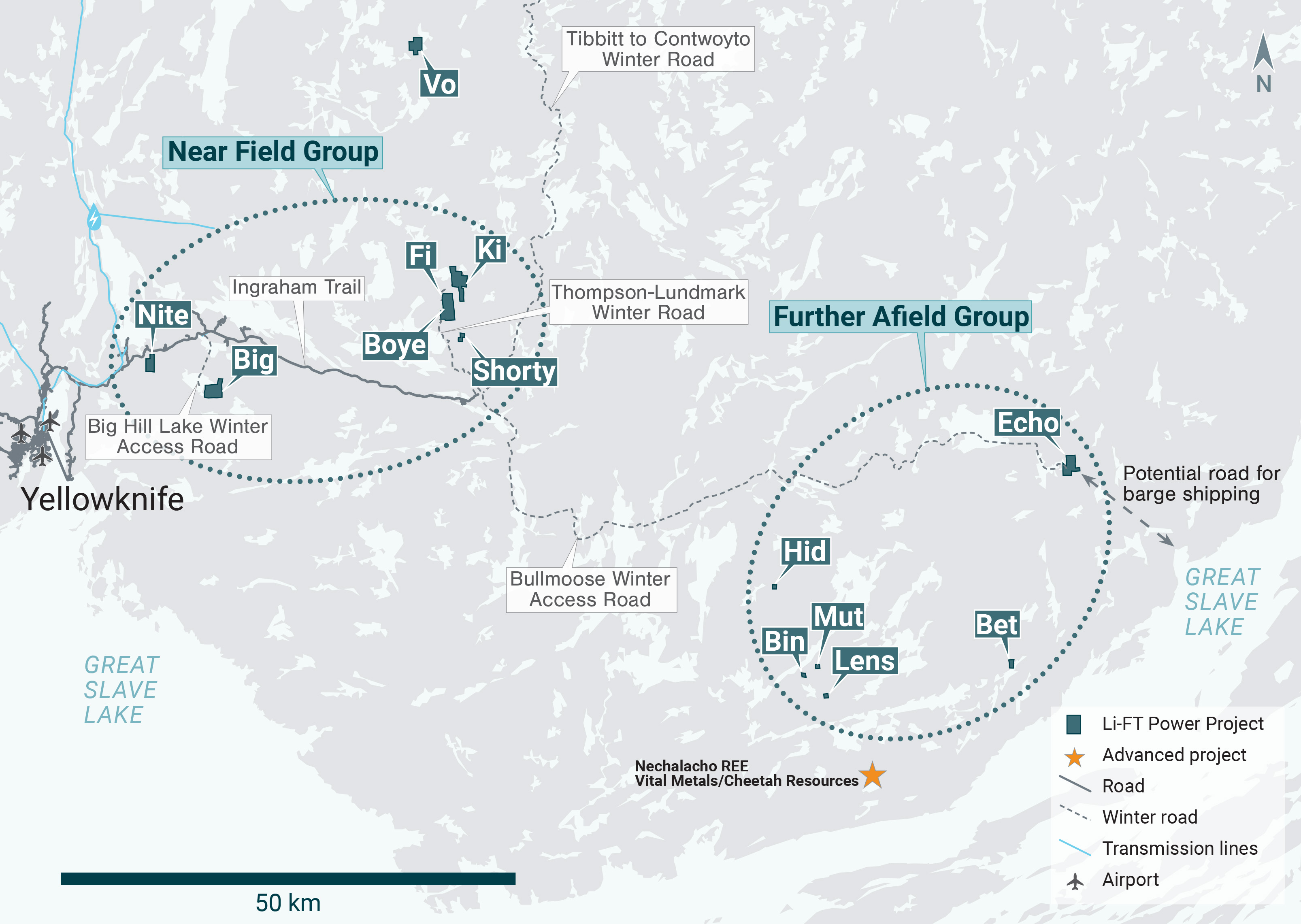
Figure 1 – Location of LIFT’s Yellowknife Lithium Project. Drilling has been thus far mainly focused on the Near Field Group of pegmatites which are located to the east of the city of Yellowknife along a government-maintained paved highway, and advancing to the Echo target, the first drilling in the Further Afield Group.
Echo Pegmatite System
The Echo pegmatite complex comprises a fanning splay of moderate to gently dipping dykes for 0.5 km to the northwest (“Echo splay”). In addition, the Echo Splay is connected to a steeply dipping, northwest-trending, feeder dyke (“Echo feeder”). The dyke complex has a total strike length of over 1.0 km. The feeder dyke is 10-15 m wide whereas the gently dipping dykes in the splay are thicker, ranging from 10-25 m.
Three (YLP-0259, 0212, 0220) holes were drilled on the Echo splay. YLP-0259 tested between the northeastern part of the splay approximately 150-200 m from where it merges, between 35-75 m below the surface, and stepped back 100 m and 150 m, respectively, from previously released drill holes YLP-0216 (
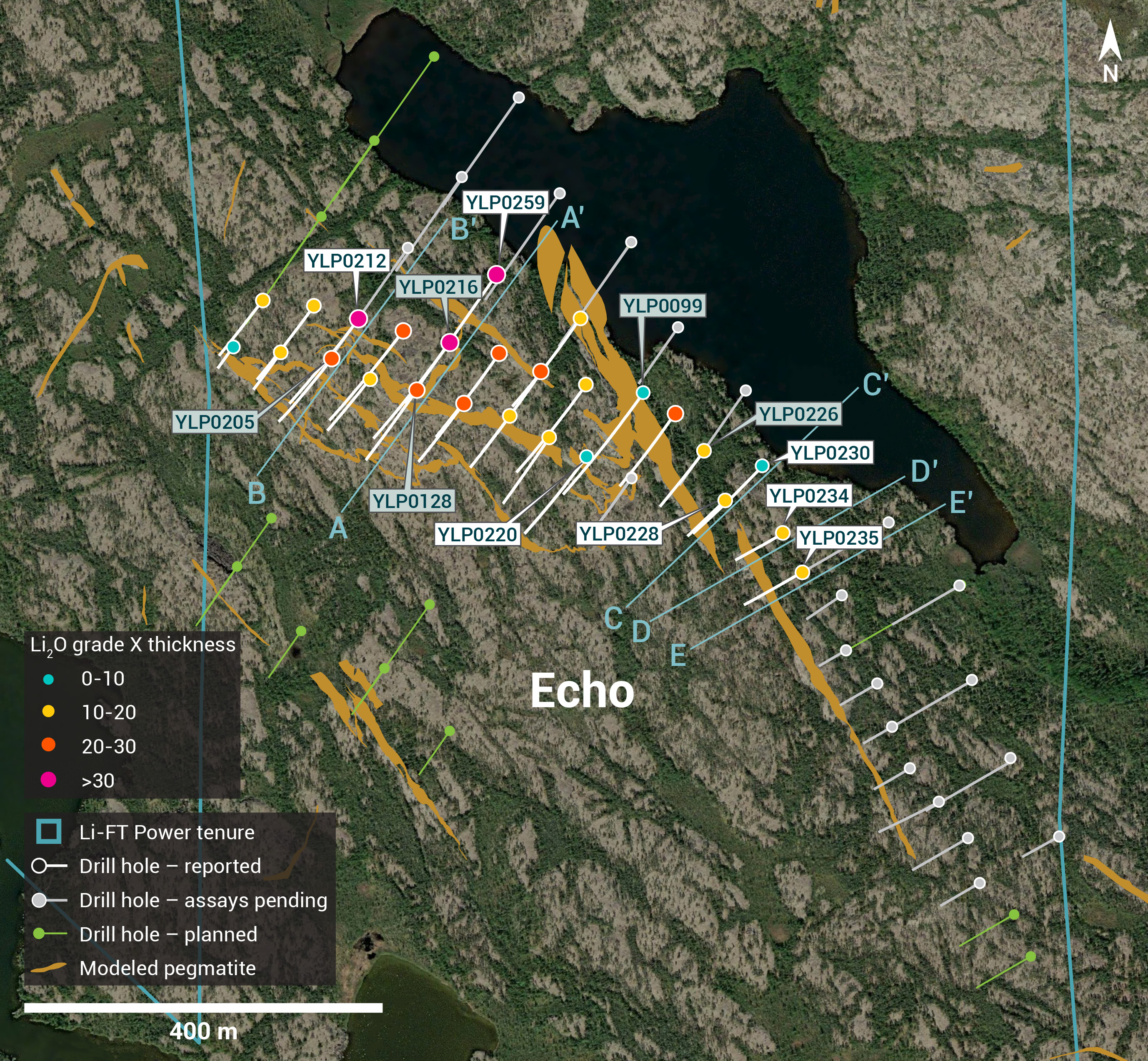
Figure 2 – Plan view showing the surface expression of the Echo pegmatite with diamond drill holes reported in this press release.
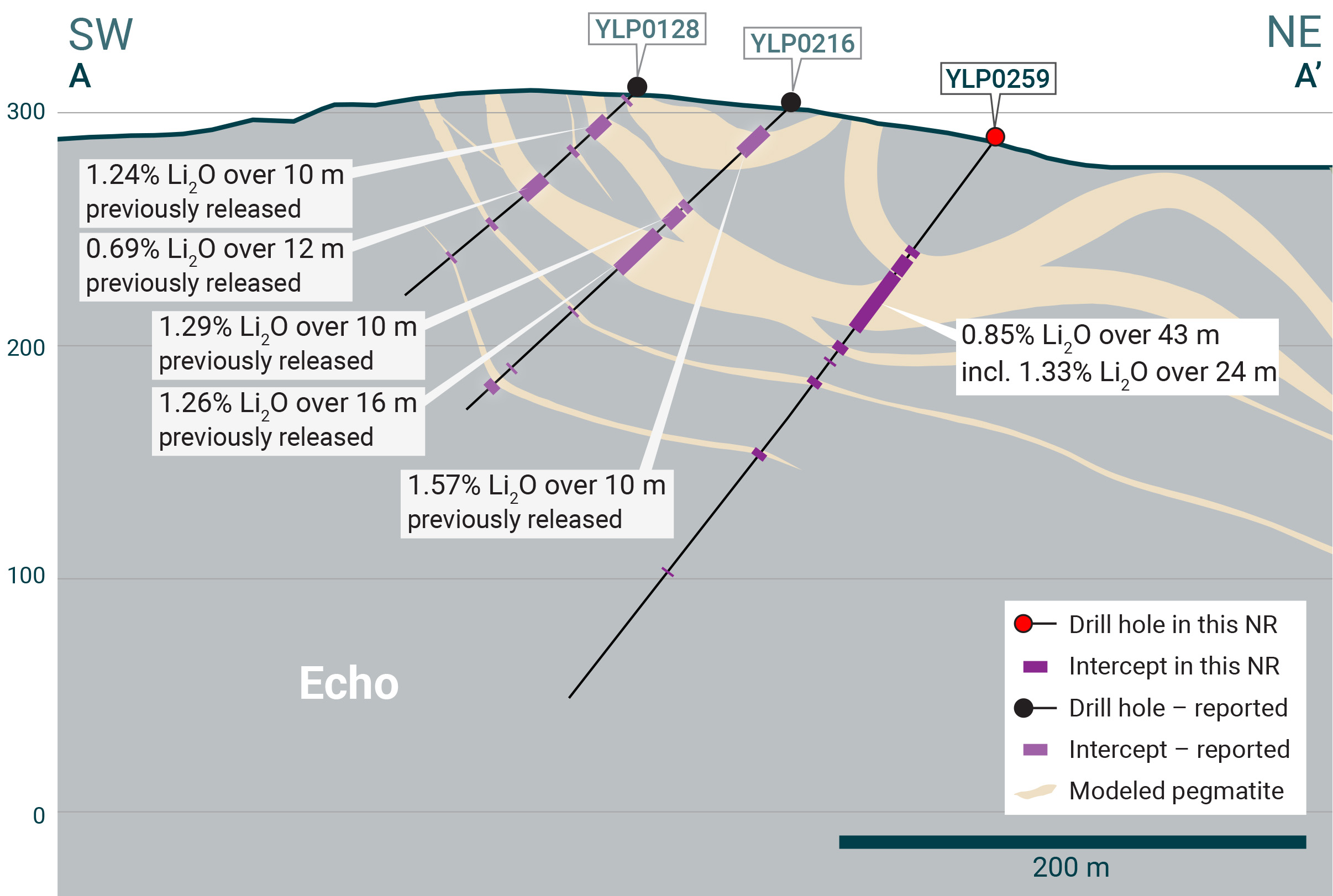
Figure 3 – Cross-section illustrating YLP-0259 with results as shown in the Echo pegmatite dyke with a 24 m interval of
YLP-0212 was drilled to test the Echo splay approximately 250-300 m from its merge zone with the feeder, <25 m to 100 m below the surface, and stepped back of 50 m from previously released YLP-0205 (
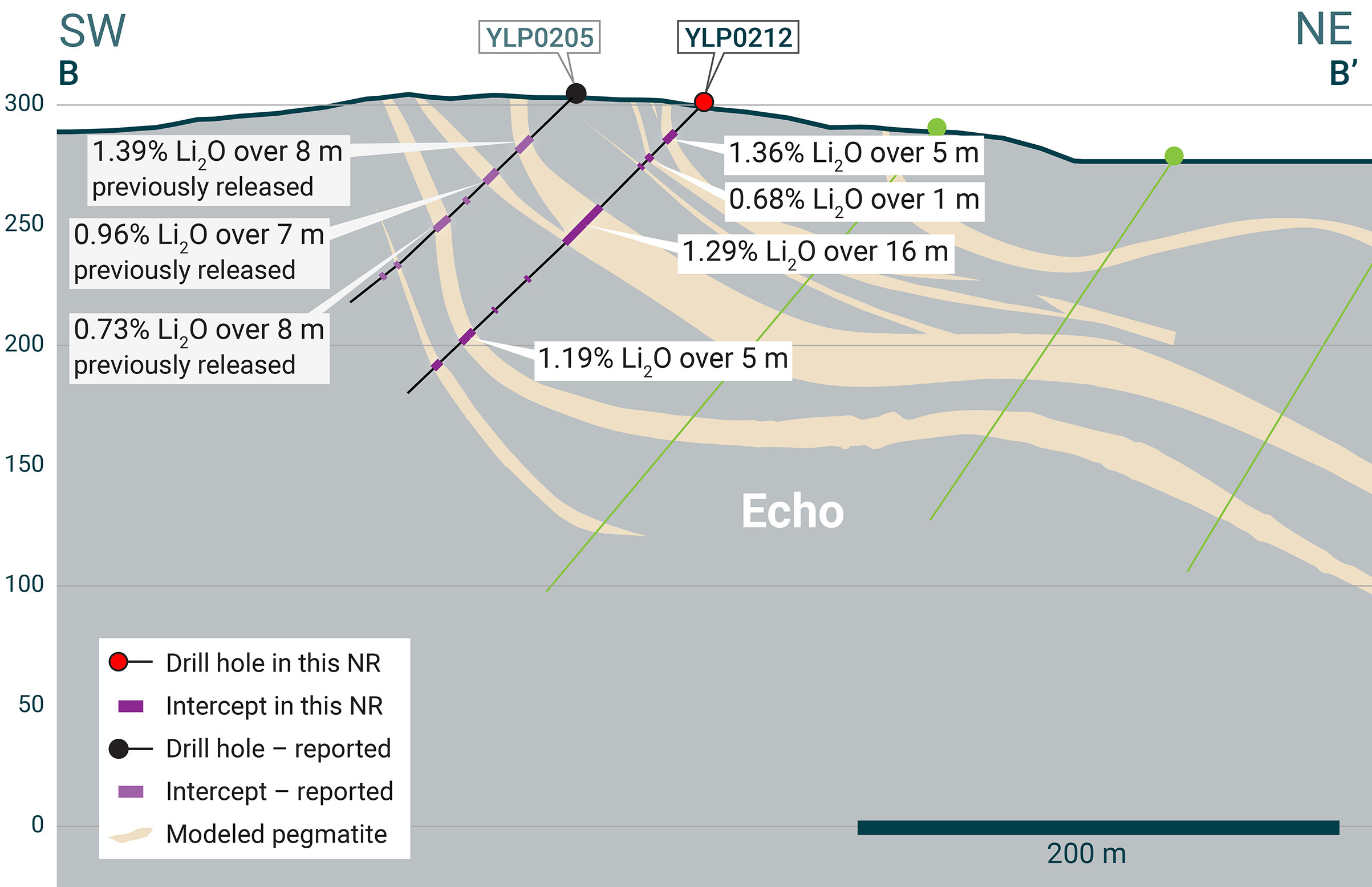
Figure 4 – Cross-section illustrating YLP-0212 with results as shown in the Echo pegmatite dyke with a 16 m interval of
Four of the seven holes reported here were drilled on the Echo feeder, with YLP-0228 designed to test the Echo feeder dyke approximately 50 m southeast of where it merges with the splay, 25-50 m below the surface, as well as along strike and 50 m southeast of previously released YLP-0226 (
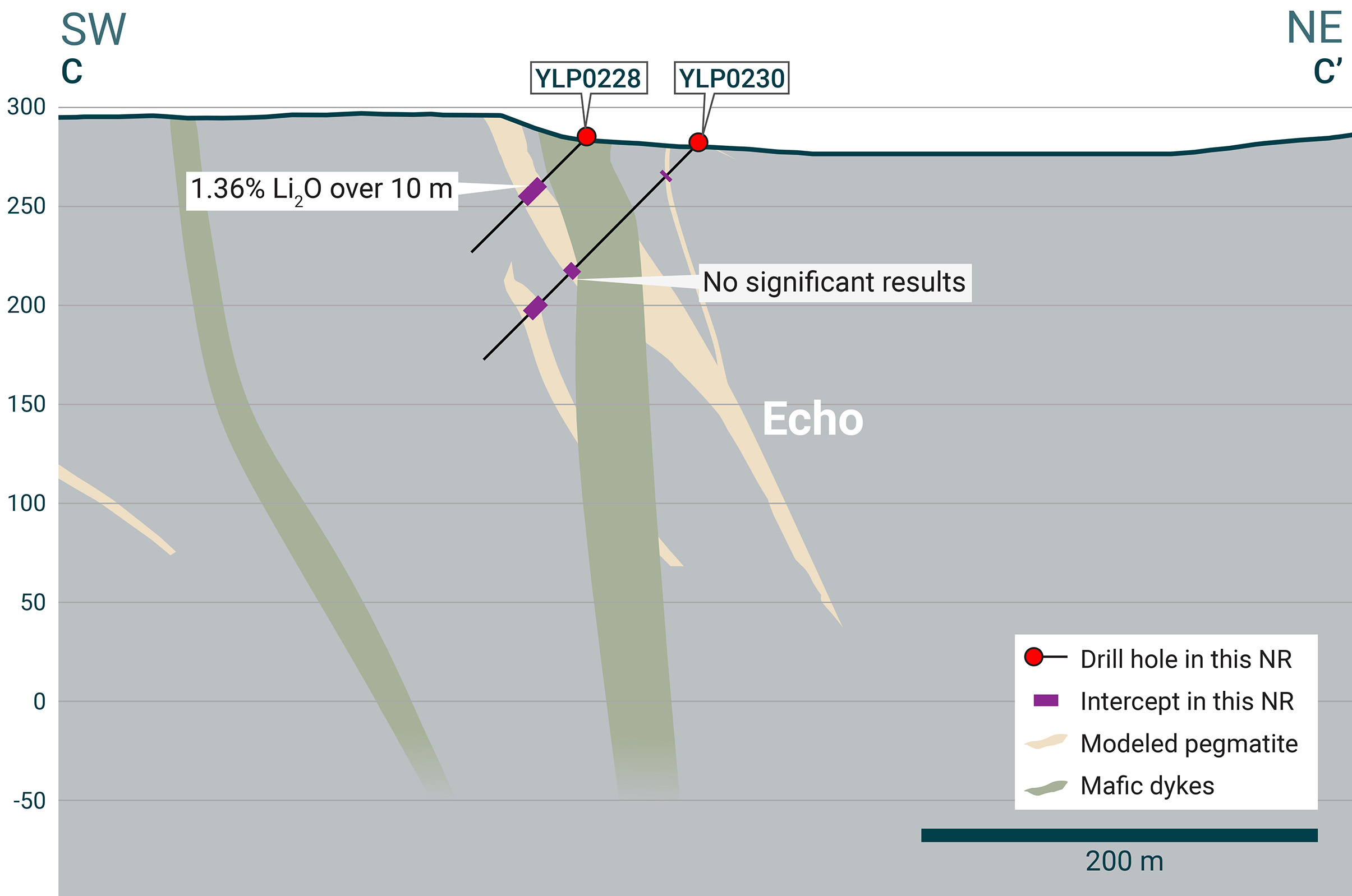
Figure 5 – Cross-section illustrating YLP-0228 with results as shown in the Echo pegmatite dyke with a 10 m interval of
YLP-0234 was drilled along strike and 50 m southeast of holes YLP-0228/0230 to test the feeder at 25-50 m below the surface. New drilling intersected a 14 m wide pegmatite that returned a composite of
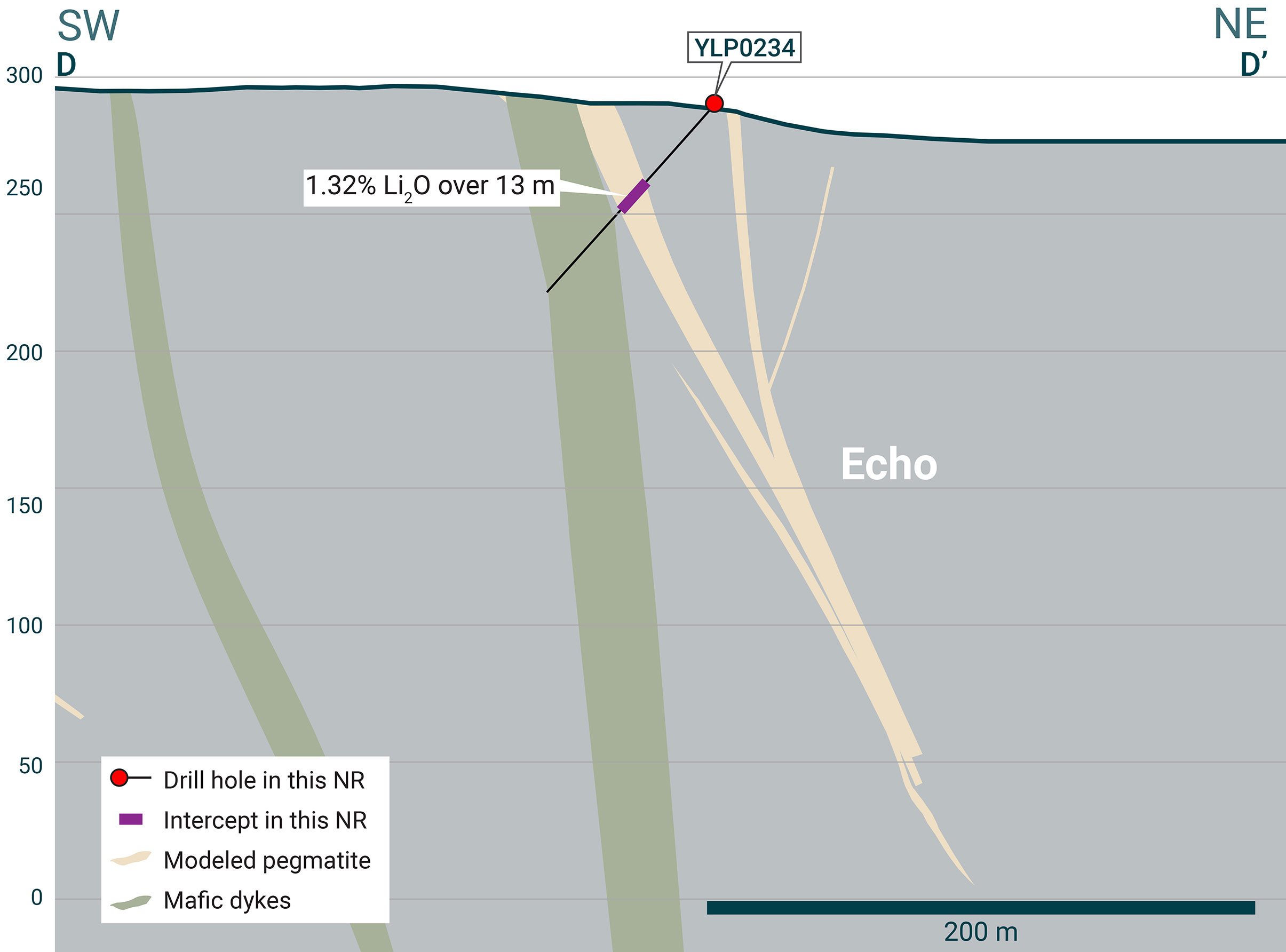
Figure 6 – Cross-section illustrating YLP-0234 with results as shown in the Echo pegmatite dyke with a 13 m interval of
YLP-0235 tested the Echo feeder dyke another 50 m along strike and southeast of YLP-0234 with new drilling intersecting a 10 m wide pegmatite dyke that returned a wall-to-wall composite of

Figure 7 – Cross-section illustrating YLP-0235 with results as shown in the Echo pegmatite dyke with a 10 m interval of
YLP-0220 was collared in the area where the splay merges with the feeder dyke and stepped forward 100 m from previous released YLP-0099 (
YLP-0230 was drilled on the same section as YLP-0228 to test the Echo feeder at 75-100 m below the surface and 50 m downdip of YLP-0228 (see above). Drilling intersected mostly mafic dyke where the feeder dyke was expected in addition to a new pegmatite further down the hole, for 17 m of pegmatite within a 35 m interval. Assays returned no significant grades (Table 1 & 2, Figure 2).
Fi Main Pegmatite
The Fi Main pegmatite complex crops out over at least 1.5 km of strike length within a north-south striking corridor that dips between 70°-85° to the west. The central 800-900 m of the complex can be split into a northern part where most pegmatite occurs in a single 25-30 m thick dyke and a southern part where this dyke splits into upper and lower pegmatites that then remerge 450 m further south. The width of the Fi Main corridor ranges from 25-75 m where it is dominated by a single dyke and between 75-150 m where it is split into two.
Two (YLP-0237, 0214) holes were drilled where the Fi Main dyke is split into an upper and lower zone, with YLP-0237 drilled to test the upper and lower pegmatites at 25 m and 100 m below the surface, respectively. This hole was collared along strike and 50 m south of previously released YLP-0013 (

Figure 8 – Plan view showing the surface expression of the Fi Main pegmatite with diamond drill holes reported in this press release.
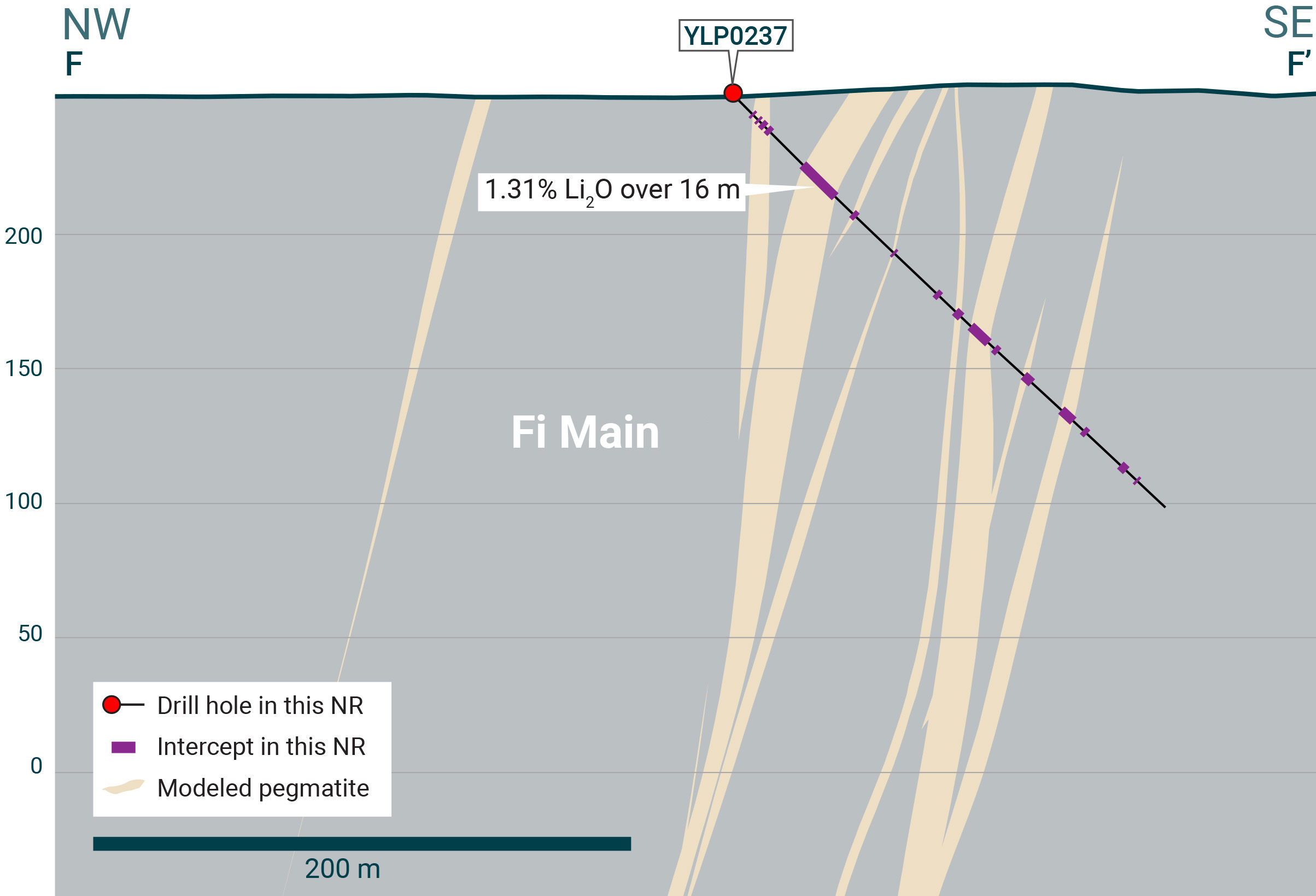
Figure 9 – Cross-section illustrating YLP-0237 with results as shown in the Fi Main pegmatite dyke with a 16 m interval of
YLP-0229 was drilled on a section located 50 m south of the section with YLP-0224. Drilling intersected a 109 m wide corridor with 46 m of pegmatite spread over seven dykes between 2-17 m in width. The two thickest dykes (9 m and 17 m) likely represent the remerging upper and lower pegmatites and returned a combined composite of

Figure 10 – Cross-section illustrating YLP-0229 with results as shown in the Fi Main pegmatite dyke with a 9 m interval of
YLP-0214 was collared on a section 50 m north of YLP-0237 to test the upper and lower pegmatites at approximately 100-200 m beneath the surface. Previously released drilling on the same section returned
YLP-0218 was collared near where the single thick Fi Main dyke splits into the upper and lower pegmatites and on a section 100 m north of YLP-0214. Drilling was designed to test the Fi Main dyke at 150 m beneath the surface as well as 75 m downdip of previously released YLP-0015 (
Two (YLP-0224, 0229) of eight holes on the southern part of the split and upper and lower pegmatites, near where they merge back into a single narrower corridor. YLP-0224 was designed to test this corridor at 125-250 m below the surface and 75-100 m downdip of previously released YLP-0010 (
Drill holes YLP-0225, 0227, and 0231 were all drilled at the north end of the Fi Main pegmatite complex where a single thick dyke splits into several thinner dykes spread over a broader corridor (“north splay”). YLP-0225 was drilled on a section located 50 m north of previously released YLP-0024 (
YLP-0227 and 0231 were drilled on a section 50 m north of YLP-0225 to test the north splay at 75 m and 150 m beneath the surface, respectively. YLP-0227 intersected a 112 m wide corridor with 48 m of pegmatite spread over seven dykes between 1-23 m in width. Six of these dykes returned average grades of ≤
YLP-0231 was drilled 50 m downdip of YLP-0227 and intersected a 69 m wide corridor with 56 m of pegmatite, most of which occurs in two pegmatite dykes that are 22 m and 32 m wide. The 22 m wide dyke has an average wall-to-wall grade of
Fi Southwest Pegmatite
The Fi Southwest (Fi-SW) pegmatite complex is exposed over at least 1.1 km on surface and occurs within a broader corridor that is 50-100 m wide and dips between 60°-80° to the east. The complex is cored by a 20-40 m wide main dyke that is continuous for at least 800 m along strike, with numerous sub-parallel subsidiary dykes between 1-5 m in width. At its northern and southern ends, the main dyke splays out into a broader corridor with more dykes that have narrower widths.
Holes YLP-0210 and YLP-0215 were both drilled as part of a 400 m long drill fence that tests the broad corridor stretching from the north tip of the Fi-SW dyke to the Fi Main corridor located 350-400 m to the east. Previously released drilling on this fence returned

Figure 11– Plan view showing the surface expression of the Fi Southwest pegmatite with diamond drill holes reported in this press release.
Table 1 – Assay highlights for drill holes reported in this press release
| Hole No. | From (m) | To (m) | Interval (m) | Li2O% | Dyke | |
| YLP-0210 | No significant results | Fi-SW | ||||
| YLP-0212 | 16 | 21 | 5 | 1.36 | Echo | |
| and | 31 | 32 | 1 | 0.68 | ||
| and | 62 | 78 | 16 | 1.29 | ||
| and | 134 | 139 | 5 | 1.19 | ||
| YLP-0214 | No significant results | Fi Main | ||||
| YLP-0215 | No significant results | Fi-SW | ||||
| YLP-0218 | 58 | 59 | 1 | 0.81 | Fi Main | |
| YLP-0220 | 8 | 17 | 9 | 0.96 | Echo | |
| inc | 10 | 15 | 5 | 1.52 | ||
| YLP-0224 | 152 | 162 | 10 | 0.89 | Fi Main | |
| inc | 155 | 159 | 4 | 1.48 | ||
| YLP-0225 | 41 | 43 | 2 | 0.53 | Fi Main | |
| and | 94 | 95 | 1 | 0.59 | ||
| YLP-0227 | 101 | 102 | 1 | 0.51 | Fi Main | |
| YLP-0228 | 31 | 41 | 10 | 1.36 | Echo | |
| YLP-0229 | 46 | 55 | 9 | 1.28 | Fi Main | |
| and | 108 | 120 | 12 | 0.54 | ||
| YLP-0230 | No significant results | Echo | ||||
| YLP-0231 | 174 | 184 | 10 | 0.57 | Fi Main | |
| YLP-0234 | 37 | 50 | 13 | 1.32 | Echo | |
| YLP-0235 | 37 | 47 | 10 | 1.25 | Echo | |
| YLP-0237 | 37 | 53 | 16 | 1.31 | Fi Main | |
| YLP-0259 | 57 | 100 | 43 | 0.85 | Echo | |
| inc | 75 | 99 | 24 | 1.33 | ||
General Statements
All 17 holes described in this news release were drilled broadly perpendicular to the dyke orientation so that the true thickness of reported intercepts will range somewhere between 65
Mineralogical characterization through hyperspectral core scanning and X-ray diffraction work shows that a very high proportion of Li2O reports to spodumene, consistent with the strong correlation between Li2O % and abundance of hyper spectral spodumene.
Table 2 - Drill collars table of reported drill holes in this press release
| Drill Hole | NAD83 | Easting | Northing | Elevation (m) | Depth (m) | Azimuth (°) | Dip (°) | Dyke | ||
| YLP-0210 | Zone 12N | 371,725 | 6,941,045 | 252 | 302 | 58 | 432 | Fi-SW | ||
| YLP-0212 | Zone 12N | 439,044 | 6,922,724 | 302 | 215 | 46 | 171 | Echo | ||
| YLP-0214 | Zone 12N | 371,669 | 6,941,641 | 252 | 98 | 50 | 315 | Fi Main | ||
| YLP-0215 | Zone 12N | 371,650 | 6,941,086 | 251 | 300 | 57 | 342 | Fi-SW | ||
| YLP-0218 | Zone 12N | 371,659 | 6,941,741 | 251 | 98 | 49 | 285 | Fi Main | ||
| YLP-0220 | Zone 12N | 439,301 | 6,922,574 | 302 | 216 | 45 | 147 | Echo | ||
| YLP-0224 | Zone 12N | 371,638 | 6,941,351 | 251 | 345 | 100 | 55 | Fi Main | ||
| YLP-0225 | Zone 12N | 371,784 | 6,942,074 | 254 | 132 | 98 | 45 | Fi Main | ||
| YLP-0227 | Zone 12N | 371,798 | 6,942,124 | 255 | 141 | 98 | 45 | Fi Main | ||
| YLP-0228 | Zone 12N | 439,454 | 6,922,521 | 286 | 81 | 223 | 45 | Echo | ||
| YLP-0229 | Zone 12N | 371,731 | 6,941,274 | 250 | 93 | 55 | 216 | Fi Main | ||
| YLP-0230 | Zone 12N | 439,496 | 6,922,560 | 281 | 153 | 224 | 46 | Echo | ||
| YLP-0231 | Zone 12N | 371,687 | 6,942,140 | 254 | 255 | 98 | 51 | Fi Main | ||
| YLP-0234 | Zone 12N | 439,517 | 6,922,483 | 288 | 240 | 49 | 90 | Echo | ||
| YLP-0235 | Zone 12N | 439,534 | 6,922,444 | 287 | 102 | 240 | 45 | Echo | ||
| YLP-0237 | Zone 12N | 371,757 | 6,941,565 | 251 | 222 | 92 | 45 | Fi Main | ||
| YLP-0259 | Zone 12N | 439,195 | 6,922,772 | 288 | 300 | 215 | 54 | Echo |
QA/QC & Core Sampling Protocols
All drill core samples were collected under the supervision of LIFT employees and contractors. Drill core was transported from the drill platform to the core processing facility where it was logged, photographed, and split by diamond saw prior to being sampled. Samples were then bagged, and blanks and certified reference materials were inserted at regular intervals. Field duplicates consisting of quarter-cut core samples were also included in the sample runs. Groups of samples were placed in large bags, sealed with numbered tags in order to maintain a chain-of-custody, and transported from LIFT’s core logging facility to ALS Labs (“ALS”) laboratory in Yellowknife, Northwest Territories.
Sample preparation and analytical work for this drill program were carried out by ALS. Samples were prepared for analysis according to ALS method CRU31: individual samples were crushed to
Qualified Person
The disclosure in this news release of scientific and technical information regarding LIFT’s mineral properties has been reviewed and approved by Ron Voordouw, Ph.D., P.Geo., Partner, Director Geoscience, Equity Exploration Consultants Ltd., and a Qualified Person as defined by National Instrument 43-101 Standards of Disclosure for Mineral Projects (NI 43-101) and member in good standing with the Northwest Territories and Nunavut Association of Professional Engineers and Geoscientists (NAPEG) (Geologist Registration number: L5245).
About LIFT
LIFT is a mineral exploration company engaged in the acquisition, exploration, and development of lithium pegmatite projects located in Canada. The Company’s flagship project is the Yellowknife Lithium Project located in Northwest Territories, Canada. LIFT also holds three early-stage exploration properties in Quebec, Canada with excellent potential for the discovery of buried lithium pegmatites, as well as the Cali Project in Northwest Territories within the Little Nahanni Pegmatite Group.
| For further information, please contact: | |
| Francis MacDonald Chief Executive Officer Tel: + 1.604.609.6185 Email: info@li-ft.com Website: www.li-ft.com | Daniel Gordon Investor Relations Manager Tel: +1.604.609.6185 Email: investors@li-ft.com |
Cautionary Statement Regarding Forward-Looking Information
Certain statements included in this press release constitute forward-looking information or statements (collectively, “forward-looking statements”), including those identified by the expressions “anticipate”, “believe”, “plan”, “estimate”, “expect”, “intend”, “may”, “should” and similar expressions to the extent they relate to the Company or its management. The forward-looking statements are not historical facts but reflect current expectations regarding future results or events. This press release contains forward looking statements. These forward-looking statements and information reflect management's current beliefs and are based on assumptions made by and information currently available to the company with respect to the matter described in this new release.
Forward-looking statements involve risks and uncertainties, which are based on current expectations as of the date of this release and subject to known and unknown risks and uncertainties that could cause actual results to differ materially from those expressed or implied by such statements. Additional information about these assumptions and risks and uncertainties is contained under "Risk Factors" in the Company's latest annual information form filed on March 27, 2024, which is available under the Company's SEDAR+ profile at www.sedarplus.ca, and in other filings that the Company has made and may make with applicable securities authorities in the future. Forward-looking statements contained herein are made only as to the date of this press release and we undertake no obligation to update or revise any forward-looking statements whether as a result of new information, future events or otherwise, except as required by law. We caution investors not to place considerable reliance on the forward-looking statements contained in this press release.
Neither the TSX Venture Exchange nor its Regulation Services Provider (as that term is defined in the policies of the TSX Venture Exchange) accepts responsibility for the adequacy or accuracy of this news release.
Photos accompanying this announcement are available at
https://www.globenewswire.com/NewsRoom/AttachmentNg/7afb2c91-7df1-4d8f-94ac-7ef0ac88ce1e
https://www.globenewswire.com/NewsRoom/AttachmentNg/1fc7c96e-d882-4ab8-9e0c-b7b12d1ea6b6
https://www.globenewswire.com/NewsRoom/AttachmentNg/83420e96-5970-40cd-8c88-c8ebe6f7e154
https://www.globenewswire.com/NewsRoom/AttachmentNg/db4b7614-598a-4413-bede-8d8fd7ce879d
https://www.globenewswire.com/NewsRoom/AttachmentNg/56e9cccd-cda9-4fbe-bfa9-23f650b87413
https://www.globenewswire.com/NewsRoom/AttachmentNg/f07cce2b-ba5a-487e-8817-2ef1bfbb4b9c
https://www.globenewswire.com/NewsRoom/AttachmentNg/f3d9de22-11ad-4ba6-b953-943f2f453ec4
https://www.globenewswire.com/NewsRoom/AttachmentNg/060563a2-10b8-44f4-8433-ba607f86eae2
https://www.globenewswire.com/NewsRoom/AttachmentNg/8e75531d-f323-4513-812f-dc4ac51bfcb4
https://www.globenewswire.com/NewsRoom/AttachmentNg/927704d6-0650-42bc-bb72-7b2cb099846e
https://www.globenewswire.com/NewsRoom/AttachmentNg/9cb3e731-4429-4b99-a712-efe65126697a








